Over the past few weeks, the oil market has been very active. Since hitting an all time high of $78.40 back in July, crude prices have plummeted to 19-month lows. Half of the 34 percent or $26 dollar a barrel drop actually began the week before Christmas and with virtually no retracement since then, traders have been wondering how much further oil prices can slide and what the latest movements mean for the rest of the markets. As the lifeblood of modern civilization, it is difficult to find one country that can escape the impact of oil, may it be positive or negative.
Why Has Oil Sold Off So Aggressively?
In order to forecast where oil is headed, we need to first understand why it has sold off so aggressively over the past few weeks. First off, the weather has been extremely erratic last year with unseasonably warm weather. In fact, according to the National Climatic Data Center, 2006 was the warmest on record for the United States, especially in the month of December. This caused inventories levels to rise, which exacerbated the drop in oil. Illustrating the severity of the unusual temperatures, just last weekend, the weather in the NYC was over 70 degrees. After losing a great deal of money trying to stay long oil in the first half of 2006, large speculators like hedge funds have flipped their positions in the fourth quarter of last year according to the IMM reports and since then, they have been consistently adding to their short oil bets week after week.
How Long Will the Weakness Continue?
Although oil is a difficult animal to forecast, both fundamentals and technicals favor a near term bottom. Snow is about to hit Southern California while temperatures in the Northeast is predicted to drop below freezing mid next week. Hotspots are beginning to heat up once again as the US suspects North Korea of gearing up for another missile test, Israel threatens to attack Iran and Russia shuts down its oil pipeline to Belarus. Fresh violence in Nigeria is also posing a big risk to the country√Ę‚,¨‚"Ęs oil production facilities. We expect OPEC to step up to the plate relatively soon to call for an emergency production cut. Even though their cuts in the past have not shifted the trend of oil prices, it has helped to stage recoveries. Furthermore, credit is still cheap and whenever financing is cheap, it helps to drive an aggressive appetite for expansions, mergers and acquisitions. With many emerging countries still hungry for oil as their economies modernize, such as China and India, long term demand for oil is here to stay.
Technically, oil prices have hit a very important support level. They have stalled right below the 38.2 percent Fibonacci retracement of the $16.70 - $78.40 a barrel rally in oil prices that lasted for close to five years. This is not far from the same point that prices stalled back in November. Although the latest move has taken crude prices below the support zone, prices have rallied on Friday, suggesting that the commodity may have found support here.
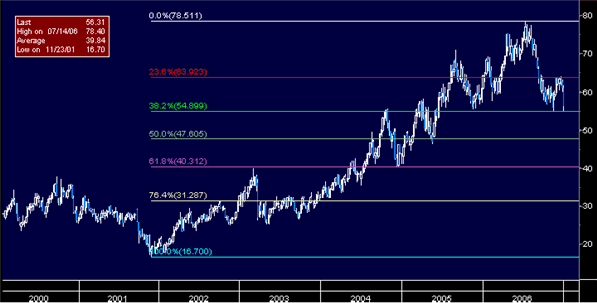
How will this impact the Currency Market?
The biggest beneficiary of a rebound in oil prices is the Canadian dollar. Canada is the world√Ę‚,¨‚"Ęs second largest holder of oil reserves and the US√Ę‚,¨‚"Ę most significant oil supplier. Unbeknownst to many, the size of their oil reserves is second only to Saudi Arabia. The geographical proximity between the US and Canada as well as the growing political uncertainty in the Middle East, Africa and South America makes Canada the preferred importer of oil to the US. Yet Canada does not just service US demand. The country√Ę‚,¨‚"Ęs vast oil resources are beginning to get a lot of attention from China especially since Canada has recently discovered a new source of oil after a reclassification of their Alberta oil sands to the economically recoverable category. China currently imports 32% of its oil and according to a report by the International Energy Agency, China√Ę‚,¨‚"Ęs import needs are expected to double by 2010 and match that of the US by 2030. The Canadian economy pulled back with the latest drop in commodity prices, so a rebound could have a meaningful impact on growth.
There are two currencies that can be sold against the Canadian dollar to express the long oil view, which are the Japanese Yen and the US dollar.
Japan imports 99% of its oil (compared to the US√Ę‚,¨‚"Ę 50%). Their lack of domestic sources of energy and their need to import vast amounts of crude oil, natural gas, and other energy resources makes them particularly sensitive to changes in oil prices. Although Japan has been able to better weather the fluctuations as time passes, they are still not immune to the drag that oil prices will have on the global economy. If oil prices continue to rise, it will sap global demand, weakening purchases of Japanese exports, which is expected to eventually filter into weakness in the Japanese Yen.
The chart below shows the strong relationship between oil prices and the CAD/JPY. The currency chart tends to lag the oil chart, which gives CAD/JPY traders a good amount of time to respond to the movements in the commodity. So if you think that oil prices have bottomed, you could express that view through a long CAD/JPY trade. One of the great reasons for expressing the oil trade through currencies is the ability to earn interest income, which the commodity does not offer.
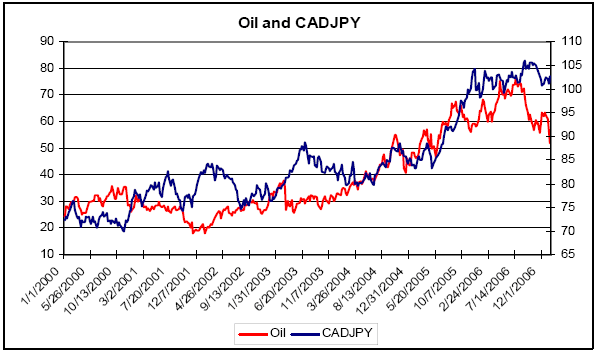
The other currency pair that can be used to express a long oil view is USD/CAD. The US dollar and the US economy has benefitted greatly from the slide in oil. Each $10 drop in price adds 0.5 percent to GDP. The lower the price of oil, the more stimulative it is for the US economy as it increases the discretionary income of US consumers. Of course, this relationship also works the other way. A rebound in oil would crimp growth as well as the pocketbooks of consumers. The following oil and CAD/USD (inverse of USD/CAD) chart shows an equally tight relationship. However, the lag between the move in oil prices and the move in the CAD/USD tends to be shorter than the reaction in the CAD/JPY. If you believe that oil prices will rebound and you want to express it through USD/CAD, you would need to short USD/CAD. The one thing to be careful of is that when you short USD/CAD you have to pay interest, which would not be the case if you expressed the view through CAD/JPY.
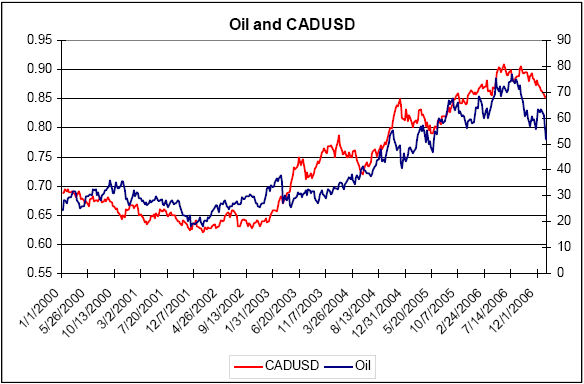
Technically, USD/CAD has been struggling to break above the 1.1800 level for the past week. Friday√Ę‚,¨‚"Ęs candle suggests that a top may be in the making, which means that if oil prices begin to rebound, there is plenty of room to fall.
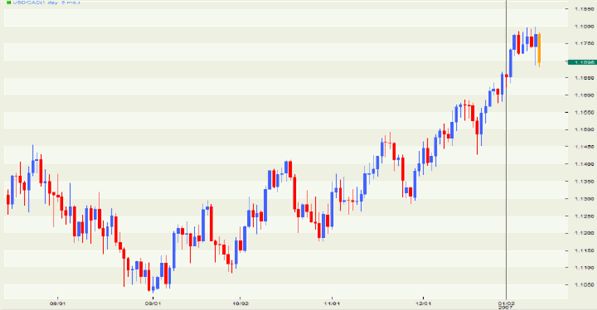
CAD/JPY on the other hand is coming up on resistance after four days of consecutive strength. It is now at a very critical level which represents not only the high from 12/20/06, but also the level where the currency broke down from in late November. Both are attractive trades but they offer different risk/reward opportunities. If you do not think that oil prices will bottom and instead will continue to fall, then the way to express a short oil trade is to go long USD/CAD and short CAD/JPY.
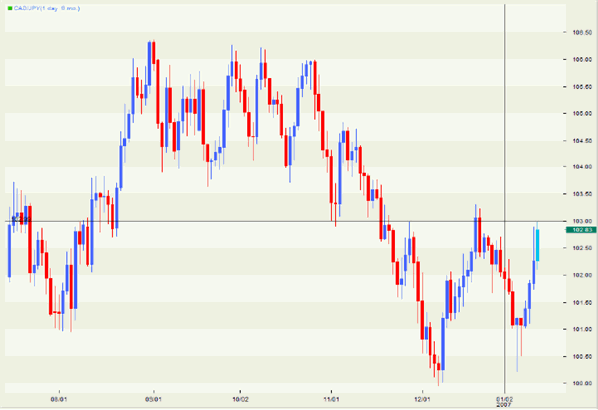
Kathy Lien is the Chief Currency Strategist at FXCM.